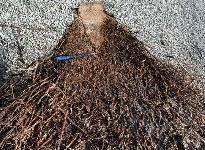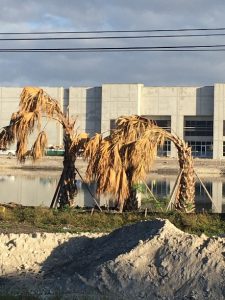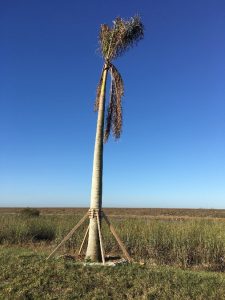Why do some palms survive transplanting and others don’t? Understanding how palm roots grow and respond to being dug up can greatly improve the chances of success when transplanting palms.
While broadleaf trees typically have only a few large primary roots originating from the base of the trunk, the entire palm root system is adventitious (all the roots arise from the trunk). This site is called the root initiation zone. Because of these root system characteristics and the ability of their trunks to store water and carbohydrates, palms are relatively easy to transplant—even large specimens with small root balls—resulting in instant, mature landscapes.


However, research from Drs. Broschat and Donselman showed that different species of palms have different tolerance and strategies to survive the transplanting process. For example, when transplanting coconuts (Cocos nucifera), about half of the cut roots survive and produce new roots regardless of their length. Sabal palm (Sabal palmetto), none of the root stubs survived, regardless of their length. For queen palm (Syagrus romanzoffiana), wild date palm (Phoenix reclinata), royal (Roystonea regia) and washingtonia (Washingtonia robusta), the percentage of roots surviving was directly proportional to the length of the remaining stubs. This research is very useful in determining the minimum rootball size for successful transplanting. For example, the rootball size is small for sabal, since digging up a larger rootball will not improve survival of existing roots. Similarly, the rootball for coconut needs not to be large since survival of existing roots is similar for both short and long root stubs. For queen palms, the minimum rootball radius should be 6–12 inches from the trunk. For washingtonia and royal palms, 1–2 feet is the minimum recommended rootball radius. A rootball radius of 2–3 feet is recommended for wild date palm. Keep in mind that rootballs are three-dimensional, and rootball depth contributes to root survival.

The key ingredient for successfully transplanting palms is water! A shallow berm should be constructed around the perimeter of the rootball of the newly transplanted palm to retain water in the rootball area during irrigation. The soil around the rootball should be kept uniformly moist, but never saturated during the first four to six months following transplanting. After that time, irrigation frequency can be reduced or eliminated altogether if adequate rainfall is received.

References:
Broschat, T. Transplanting Palms in the Landscape, 2017. EDIS publication #CIR1047
http://edis.ifas.ufl.edu/ep001
Hodel, D. Biology of Palms and Implications for Management in the Landscape. 2009. HortTechnology. 19 (4): 676-681
http://horttech.ashspublications.org/content/19/4/676.full
 0
0
